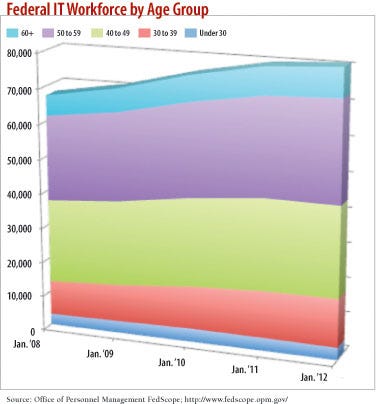Federal IT Staffing Mess: Budget Chaos + Aging WorkforceFederal IT Staffing Mess: Budget Chaos + Aging Workforce
Recurring budget questions and Congressional showdowns are driving away mid-rank IT talent, leaving an older workforce just when new talent is needed most.


Federal agencies are headed toward a cruel dilemma. Just as new technologies promise a once-in-a-generation opportunity to recast U.S. government operations and slash costs, thinning ranks of mid-tier IT workers and a graying federal IT workforce suggest that agencies won't have the right mix of staffing and skills to take advantage of those technologies.
It's not that the federal government hasn't been hiring people. The number of permanent federal IT employees is up 20% since 2008, in part to support growing cybersecurity demands in federal agencies. Despite a series of federal budget cuts including the sequestration this year, the number of permanent federal IT employees has increased steadily every year since 2008, from 67,300 to nearly 81,000 as of September 2012, and the growth only leveled off in the first quarter of 2013, according to figures from the Office of Personnel Management (OPM).
And the federal government is offering competitive wages. Government IT staffers today are better paid than many in IT, contrary to popular wisdom, ranking 10th among 30 U.S. industries, according to information's 2013 Salary Survey. While government IT managers don't fare as well because they aren't eligible for the same kinds of bonuses as their private-sector peers, they still rank in the middle (16th) in terms of total compensation out of 30 industries surveyed.
But three years of salary freezes and broadening uncertainty about the future funding of many government programs have taken their toll on federal employees. That uncertainty grows more entrenched each year as Congress lunges from one stop-gap funding measure to another -- and as lawmakers once again threaten to leave 2.1 million federal employees on the brink of a government shutdown Oct. 1.
[ Is it going to get even worse? See Sequestration II: Expect Budget Rollercoaster In 2014. ]
Those and other factors have spurred the largest wave of retirements across the federal government in nearly two decades, with about 80,000 federal employees -- about 5% of the workforce -- expected to retire this year, according to OPM. It also is prompting many mid-level federal IT specialists, in particular, to look elsewhere for work.
Of greater concern to many government IT experts, however, is the resulting makeup of the federal IT workforce. Agencies are being left with a disproportionate number of older IT workers who know how to run legacy systems, and a shortage of younger workers who've grown up in the age of Web-based and mobile computing and who represent the next generation of federal IT leaders.
The Bathtub Effect
An analysis by information of federal employment data reveals that 46% of the 80,919 IT workers permanently employed by the federal government as of September 2012 were age 50 or older -- including a significant number (more than 10%) who were 60 or older. The rest of the workforce breaks down like this: 32% were 40-49; 17% were 30-39; and 4% were under 30.
Put into starker relief: There are now nearly 11 times more federal IT workers aged 50 or above than there are IT employees under the age of 30 -- up from nine times more just two years earlier.
"We're seeing the retirement wave pick up at a measurable pace. And we know the 40-to-50-year-old cohort is the lowest it's been in 10 years," said Stan Soloway, president and chief executive of the Professional Services Council, which represents the contracting community. "So you're having a diminished workforce -- and (an emptying) bathtub in the middle ranks," said Soloway. "It's not pretty."
Van Hitch, who retired as Justice Department CIO in 2011 and now works for Deloitte Consulting, is among veteran federal executives who believe the structural gaps in staffing pose serious concerns for senior management.
"The move to the cloud and IT services may offset the loss of some of the back-office IT technicians," he said. But "it will also accentuate the need for skills currently in short supply," especially for cybersecurity, project management and acquisition.
"I believe declining budgets and the move toward the cloud and IT services are not blips, but long-term trends that CIOs must plan for over the foreseeable future," Hitch said. The loss of IT talent "could hurt agencies in accomplishing their missions," unless agencies "find ways to challenge and reward their best performers and manage the overall attrition of the workforce."
Collateral Damage
The budget turmoil is spilling over into the government contracting community, which historically fills the gaps when government talent is in short supply.
Conventional system integrators and IT service providers, from Lockheed Martin to IBM and many others, have repositioned themselves quickly to provide IT services for tasks such as helping agencies move their operations to the cloud and securing data for an increasingly mobile workforce. But long-term uncertainty over program funding, and a more cutthroat contracting environment, are creating problems for contractors trying to hold onto government business -- and their best talent.
"There seems to be very little awareness in Congress of the chaos in budgeting right now," said Soloway, and the impact that's having on agencies, contractors and their employees. That chaos, he and others believe, is straining agencies already under budgetary duress and will make it hard to attract and harder to hire the IT talent the government sector needs to operate more efficiently.
"There's a massive battle for talent, particularly between Wall Street and Silicon Valley," said Soloway. "Government contractors are competing against that." Because of the political uncertainty around budgets, contractors aren't so much "losing their talent to other contractors, but to the outside world."
Soloway, as someone representing government contractors, has a particular dislike for the growing use of "lowest price, technically acceptable" (LPTA) contracts.
"It's not just a theory, it's a legal construct" that requires agencies to award contracts to the company that offers the lowest price, as long as it meets the minimum technical qualifications, said Soloway. What began as a contracting method designed to drive down government's costs has in many cases led to government IT projects being performed by companies frequently derided as "bottom feeders," with the talent and results to match, said Soloway.
Linda Rix, co-CEO of Avue Technologies, which specializes in government hiring, estimates that for every IT worker employed by the government, there is a second IT specialist working for a contractor on a government project. A loss or lowering of talent in the contracting community is likely to have a material impact on the quality and timeliness of federal IT work, Soloway and others believe.
"There's no doubt LPTA is becoming the dominant acquisition strategy for government," said Soloway. He warned that unless federal agencies rethink their acquisition approaches, the caliber of contractors willing to work with the government will decline, as will the pool of talent they employ.

Surge In Retirements
The shifts in the federal IT workforce are playing out against a backdrop of federal employees retiring in large numbers not seen since the Clinton administration, which offered early retirement incentives as part of its "reinvent government" campaign. With nearly 30% of all executive-branch workers eligible to retire by 2016, fed watchers worry that the government is about to lose a significant amount of management expertise and institutional knowledge.
Office of Personnel Management (OPM) associate director Angela Bailey isn't necessarily among them. Bailey has lived through three decades of retirement cycles in government and has learned that "retirement is a very personal decision," and not as much a function of eligibility as many believe. She also believes that experience is relative.
"If you have someone with a lot of COBOL experience, just because they're retiring with a wealth of institutional knowledge doesn't mean that's the knowledge we need going forward" as agencies move into more modern programming languages and cloud-based software. What does matter, Bailey said, is whether agency executives are "looking forward over the next three to five years at 'what talent do I need and how do I get it.'"
Bailey does think the wave of retirements is fueled by perceptions of government, and that makes it harder to retain and recruit high-performing employees. The "constant fed bashing and senseless sequestration" is wearing on those who put their "heart and soul into serving the American public ... especially those in leadership positions." IT workers are retiring at a slower rate than federal workers generally, and that might stem from a decision dating back to 2001 to let agencies pay IT specialists wages that are more competitive with the private sector, said Ira Hobbs, who served as deputy CIO at the Department of Agriculture at the time. The effort was part of a broader pay modernization initiative by OPM that was championed by Hobbs, who now consults on workforce issues.
Hobbs looks beyond the age mix of IT workers. "It doesn't matter if your workforce is old or your workforce is young. In every workforce, you need a level of diversity," he said. "Don't lose sight of the experience your older workers bring in terms of training and mentoring. The question is, are they making things work more efficiently and are they prepared for the future?"
Hobbs concedes that the thinning ranks of mid-tier IT staffers will make it harder for agencies to implement new technology solutions in the future. "The older a workforce is, the more risk averse it is and that can cause stagnation," he said.
Managing The Workforce, Not Just IT
Karen Evans is among those who opted to retire from government, in January 2009, following the change in administrations and 20 years in federal service. Her oversight of the government's $70-plus billion in annual IT spending as head of electronic government and IT in the Office of Management and Budget gave her a rich perspective on the changing mix of federal IT workers.
"I was always looking at workforce issues. You want to make sure you're grooming the next generation of leaders -- that you have people who can fill in the ranks and understand the mission, as well as the technology to accomplish it," said Evans, now national director for the U.S. Cyber Challenge, a program aimed at developing the future cyber workforce.
"It's not so much the age gap, but gaps in the (federal employment) grade structure," that concern Evans. "The mid-level is what's critical," she said, in order to "have stability for the organization so the projects you're working on can cross over from administration to administration."
However, Evans isn't as concerned that agencies won't be able to attract new talent. "I never found ... even during the dot-com boom that I had a hard time competing with private industry," she said. People are drawn to the stability in government compared with the private sector, she said, and they like the project experiences and accountability they get in government. Finding enough talent to keep up with certain needs, such as cybersecurity, remains a pressing concern though.
Feds Are Still Hiring
John Palguta, VP for policy and research at the Partnership for Public Service, has seen these cycles before. Yes, there are frustrations of working for the government and living with its uncertainties. Still, he notes that of nearly 89,700 people hired by the federal government in 2012, 5.3% of them were IT workers. That makes IT the fifth most actively recruited occupation in government (after medical, clerical, investigative and other specialty jobs) according to a new federal hiring report released by the nonprofit group Sept. 10.
Palguta also believes worries about the recent spike in retirements and the potential loss of experience has been overplayed in the media, when viewed from a historical perspective.
He does remain concerned, however, about declining employee satisfaction ratings. "Sequestration is still creating lots of problems," he said and making it harder for agencies to recruit the talent they need. "It's not a question of bringing in warm bodies. It's a matter of bringing in some of the best talent in the country to do these jobs," he said.
About the Author
You May Also Like








